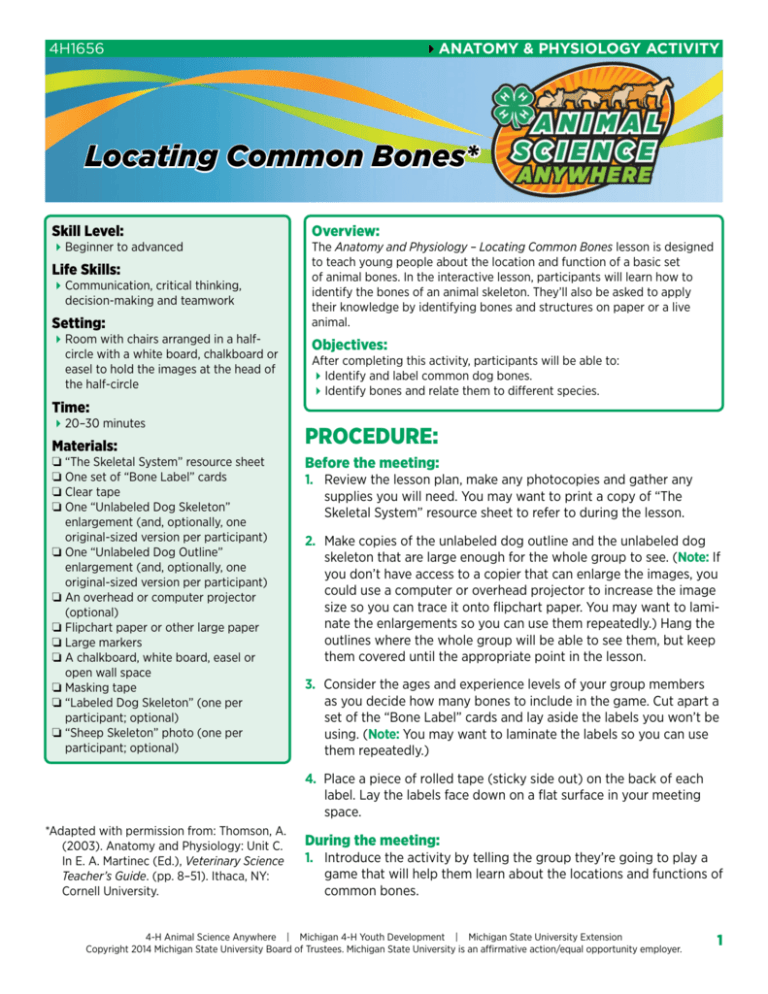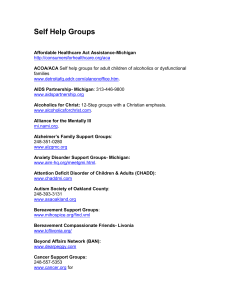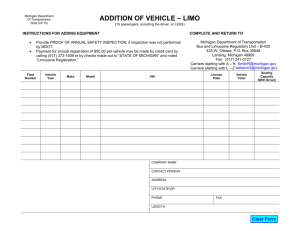
4ANATOMY & PHYSIOLOGY ACTIVITY
4H1656
Locating Common Bones*
Skill Level:
Beginner
to advanced
Life Skills:
Communication,
critical thinking,
decision-making and teamwork
Setting:
Room
with chairs arranged in a halfcircle with a white board, chalkboard or
easel to hold the images at the head of
the half-circle
Time:
20–30
minutes
Materials:
❏❏ “The Skeletal System” resource sheet
❏❏ One set of “Bone Label” cards
❏❏ Clear tape
❏❏ One “Unlabeled Dog Skeleton”
enlargement (and, optionally, one
original-sized version per participant)
❏❏ One “Unlabeled Dog Outline”
enlargement (and, optionally, one
original-sized version per participant)
❏❏ An overhead or computer projector
(optional)
❏❏ Flipchart paper or other large paper
❏❏ Large markers
❏❏ A chalkboard, white board, easel or
open wall space
❏❏ Masking tape
❏❏ “Labeled Dog Skeleton” (one per
participant; optional)
❏❏ “Sheep Skeleton” photo (one per
participant; optional)
Overview:
The Anatomy and Physiology – Locating Common Bones lesson is designed
to teach young people about the location and function of a basic set
of animal bones. In the interactive lesson, participants will learn how to
identify the bones of an animal skeleton. They’ll also be asked to apply
their knowledge by identifying bones and structures on paper or a live
animal.
Objectives:
After completing this activity, participants will be able to:
Identify
and label common dog bones.
Identify
bones and relate them to different species.
PROCEDURE:
Before the meeting:
1. Review the lesson plan, make any photocopies and gather any
supplies you will need. You may want to print a copy of “The
Skeletal System” resource sheet to refer to during the lesson.
2. Make copies of the unlabeled dog outline and the unlabeled dog
skeleton that are large enough for the whole group to see. (Note: If
you don’t have access to a copier that can enlarge the images, you
could use a computer or overhead projector to increase the image
size so you can trace it onto flipchart paper. You may want to laminate the enlargements so you can use them repeatedly.) Hang the
outlines where the whole group will be able to see them, but keep
them covered until the appropriate point in the lesson.
3. Consider the ages and experience levels of your group members
as you decide how many bones to include in the game. Cut apart a
set of the “Bone Label” cards and lay aside the labels you won’t be
using. (Note: You may want to laminate the labels so you can use
them repeatedly.)
4. Place a piece of rolled tape (sticky side out) on the back of each
label. Lay the labels face down on a flat surface in your meeting
space.
*Adapted with permission from: Thomson, A.
(2003). Anatomy and Physiology: Unit C.
In E. A. Martinec (Ed.), Veterinary Science
Teacher’s Guide. (pp. 8–51). Ithaca, NY:
Cornell University.
During the meeting:
1. Introduce the activity by telling the group they’re going to play a
game that will help them learn about the locations and functions of
common bones.
4-H Animal Science Anywhere | Michigan 4-H Youth Development | Michigan State University Extension
Copyright 2014 Michigan State University Board of Trustees. Michigan State University is an affirmative action/equal opportunity employer.
1
4ANATOMY & PHYSIOLOGY ACTIVITY
2. Ask the group the following questions:
What is a bone? (The hard parts of an animal’s skeleton.)
What are some of the main reasons animal bodies have bones?
(To protect the body’s vulnerable internal organs, to support
the structure of the body, to enable animals to move.)
Why is it important for you to know where the bones are located
in an animal’s body? (So you know where to check for broken
bones and other injuries; to make sure that equipment such
as harnesses, bridles, halters and saddles fit properly; to avoid
using a potentially damaging brush such as a curry comb on a
tender spot where the bone is close to the surface.)
Record their answers on flipchart paper and display the sheets
where everyone can see them.
3. Next ask for volunteers to name some common bones that most
animals have. As participants name a bone, describe its location
and function, then place the correct label for it on the unlabeled
dog skeleton enlargement. When the group can’t think of any
other bones, use the “Skeletal System” resource sheet to provide
information about the locations and functions of any major bones
they may have missed.
4. Now remove any labels you may have placed on the unlabeled dog
skeleton enlargement and tell the group it’s time to play the game.
5. Explain that they’ll take turns coming to the front and choosing
one of the “Bone Label” cards that are lying face down. Once
they’ve chosen a label, they will try to place it on the right spot on
the unlabeled dog skeleton.
6. After a player has finished a turn, have the next person come up
and either move the previous player’s label to what they think
is the correct bone, or choose a new label to place. Have them
continue this process until they’ve placed all of the labels on the
skeleton.
TALKING IT OVER:
Ask the group the following questions:
What was the most challenging
part of this activity?
If you were to play this game again,
what would you do differently?
Why is it important to know where
an animal’s bones are located?
How might knowing where its
bones are affect how you care for
an animal?
2
7. Now work with the group to make sure that all of the labels are
correct. If you have to move a label, explain why the correction
was needed. (Note: You can use the labeled dog skeleton from
the “Skeletal System” resource sheet if you need help making
corrections.)
8. If you have enough meeting time and the group is still interested,
play another round of the game using the dog skeleton, or play it
using the dog outline instead.
9. Challenge the group to review the bones on their animals at home
to help them continue to improve their bone identification skills.
Show them the photo of the sheep skeleton from Michigan State
University and explain that students and researchers at universities
and private companies continue to study the structure, functions
and locations of bones.
4-H Animal Science Anywhere | Michigan 4-H Youth Development | Michigan State University Extension
Copyright 2014 Michigan State University Board of Trustees. Michigan State University is an affirmative action/equal opportunity employer.
4ANATOMY & PHYSIOLOGY ACTIVITY
ADAPTATIONS & EXTENSIONS:
For Younger or Less Experienced Participants: Consider having
them play the game in two-person teams.
For Older or More Experienced Participants: Consider bringing
a live animal to the meeting that participants can paint bones
onto with washable colors. If your group has done a muscle
lesson before this meeting, they could compare muscle and bone
locations while painting in different colors.
Blindfold the players as they try to place labels on the dog
skeleton. Have their teammates guide the blindfolded player to the
correct spot using directional terminology.
Time individual players or teams to see how long it takes them to
correctly identify all the bones selected.
Have the participants identify the locations of the bones on a live
animal. Then have them relate the bone location to the animal’s
structure.
Divide the group into teams and give them copies of the “Skeletal
System” resource sheet to use as they work through the lesson
together.
Copy one set of “Bone Label” cards, labeled and unlabeled dog
skeletons and dog outlines for each participant to use during the
lesson and to take home and review.
REFERENCES & RESOURCES:
Thomson, A. (2003). Anatomy and physiology: Unit C. In E. A. Martinec
(Ed.), Veterinary science teacher’s guide (pp. 8–51). Ithaca, NY: Cornell
University.
ACKNOWLEDGMENTS:
Author: Julie Thelen, 4-H Livestock and Veterinary Science Educator,
Michigan State University Extension
This bulletin was produced by ANR Communications
(anrcom.msu.edu).
Anatomy & Physiology – Locating Common Bones
© 2014 by Michigan State University Board of Trustees. 4-H and Cooperative Extension System groups and
other nonprofit educational groups may print up to 25
hard copies of this material for noncommercial, educational use, provided that attribution is given to Michigan
State University. All other rights reserved. For information, contact 4-H Youth Development, 108 Agriculture
Hall, 446 West Circle Drive, East Lansing, MI 48824.
MSU is an affirmative-action, equal-opportunity employer, committed to achieving excellence through a
diverse workforce and inclusive culture that encourages all people to reach their full potential. Michigan
State University Extension programs and materials
are open to all without regard to race, color, national
origin, gender, gender identity, religion, age, height,
weight, disability, political beliefs, sexual orientation, marital status, family status or veteran status.
Issued in furtherance of MSU Extension work, acts
of May 8 and June 30, 1914, in cooperation with the
U.S. Department of Agriculture. Thomas G. Coon,
Director, MSU Extension, East Lansing, MI 48824.
This information is for educational purposes only.
Reference to commercial products or trade names
does not imply endorsement by MSU Extension or
bias against those not mentioned. The 4-H Name and
Emblem have special protections from Congress, protected by code 18 USC 707. 1P–Web–2:2014–RM
4-H Animal Science Anywhere | Michigan 4-H Youth Development | Michigan State University Extension
Copyright 2014 Michigan State University Board of Trustees. Michigan State University is an affirmative action/equal opportunity employer.
3
4LOCATING COMMON BONES RESOURCE SHEET
The Skeletal System*
The skeleton is a framework of bones and
cartilage structures that supports and protects
an animal’s body.
Skull – Consists of many bony plates that are fused
together.
Ribs – These are curved arches of bone extending from
the spine toward the sternum. Most animals have 13 or
more pairs of ribs (humans only have 12).
Spine – The spine is made up of bones called “vertebra”
(the plural is “vertebrae”) and has five distinct regions:
Cervical – The vertebrae of the neck region.
a. Atlas – Often called “C1,” this is the first cervical
vertebra. It forms the joint that lets you nod
“yes.”
b. Axis – Often called “C2,” this is the second
cervical vertebra. It forms the joint that lets you
shake your head “no.”
Thoracic – The vertebrae of the body region that
always have a rib attached to them and a vertebrae
on top of them.
Lumbar – The vertebrae of the lower back.
Sacral – The vertebrae of the pelvic region.
Coccygeal – The vertebrae of the tail region. Many
animals use them for balance.
Forelimbs
a. Scapula – The “shoulder blade” attached with
muscle.
b. Humerus – Forms the upper arm.
c. Ulna – Forms the elbow joint, fused with the
radius in herbivores.
d. Radius – Forms the forearm.
f. Olecranon – A projection from the ulna that forms
the point of the elbow.
g. Metacarpals – Commonly called the “cannon
region” of the forelimb. The number of
metacarpals depends on the species.
1. Humans: 5 (the bones that connect the fingers with the wrist)
2. Horses: 1 plus 2 accessory metacarpals that
are called “splint bones”
3. Dogs and cats: 4 plus the dewclaw
4. Cattle: 1 that splits at bottom into a cloven
hoof and 2 dewclaws
5. Pigs: 4 (2 toes and 2 dewclaws)
h. Phalanges – The bones of the fingers and toes
(located on the forelimb and the hind limb). Most
commonly associated with the pastern.
i. Sesamoids – The small bone at the base of the
phalanges (located on the forelimbs and the hind
limbs).
Hind limbs
a. Os coxae – The hipbone; forms the pelvis.
b. Femur – The largest and longest bone; provides
stability and strength.
c. Patella – Forms the “stifle” joint in horses, and is
equivalent to the human knee.
d. Tibia – The main bone above the hock.
e. Fibula – Fused with the tibia and considered
vestigial (functionless) in herbivores.
f. Tarsus – Commonly called the “hock,” and is
equivalent to the human ankle.
g. Metatarsal – The cannon region in the hind limb.
e. Carpus – Commonly called the “knee” in horses
and the “wrist” in dogs and humans.
*Adapted with permission from: Thomson, A. (2003). Anatomy and Physiology: Unit C. In E. A. Martinec (Ed.), Veterinary
Science Teacher’s Guide. (pp. 8-51). Ithaca, NY: Cornell University.
4
4-H Animal Science Anywhere | Michigan 4-H Youth Development | Michigan State University Extension
Copyright 2014 Michigan State University Board of Trustees. Michigan State University is an affirmative action/equal opportunity employer.
4LOCATING COMMON BONES HANDOUT
Labeled Dog Skeleton
Image from the 2003 Veterinary Science Teacher’s Guide reproduced with permission.
4-H Animal Science Anywhere | Michigan 4-H Youth Development | Michigan State University Extension
Copyright 2014 Michigan State University Board of Trustees. Michigan State University is an affirmative action/equal opportunity employer.
5
6
Photo courtesy of author.
Sheep Skeleton
4LOCATING COMMON BONES HANDOUT
4-H Animal Science Anywhere | Michigan 4-H Youth Development | Michigan State University Extension
Copyright 2014 Michigan State University Board of Trustees. Michigan State University is an affirmative action/equal opportunity employer.
4LOCATING COMMON BONES CARDS
Bone Labels
Print out and cut apart a set of labels. You may want to laminate the labels to make them sturdier so
they last longer.
Atlas
Lumbar
vertebrae
Sacral vertebrae
Axis
Metacarpals
Scapula
Carpus
Metatarsals
Sesamoids
Cervical
vertebrae
Olecranon
Skull
Coccygeal
vertebrae
Os coxae
Tarsus
Femur
Patella
Thoracic
vertebrae
Fibula
Phalanges
Tibia
Humerus
Radius
Ulna
Ribs
4-H Animal Science Anywhere | Michigan 4-H Youth Development | Michigan State University Extension
Copyright 2014 Michigan State University Board of Trustees. Michigan State University is an affirmative action/equal opportunity employer.
7
8
Image from the 2003 Veterinary Science Teacher’s Guide reproduced with permission.
Unlabeled Dog Outline
4LOCATING COMMON BONES HANDOUT
4-H Animal Science Anywhere | Michigan 4-H Youth Development | Michigan State University Extension
Copyright 2014 Michigan State University Board of Trustees. Michigan State University is an affirmative action/equal opportunity employer.
4LOCATING COMMON BONES HANDOUT
Unlabeled Dog Skeleton
Image from the 2003 Veterinary Science Teacher’s Guide reproduced with permission.
4-H Animal Science Anywhere | Michigan 4-H Youth Development | Michigan State University Extension
Copyright 2014 Michigan State University Board of Trustees. Michigan State University is an affirmative action/equal opportunity employer.
9









